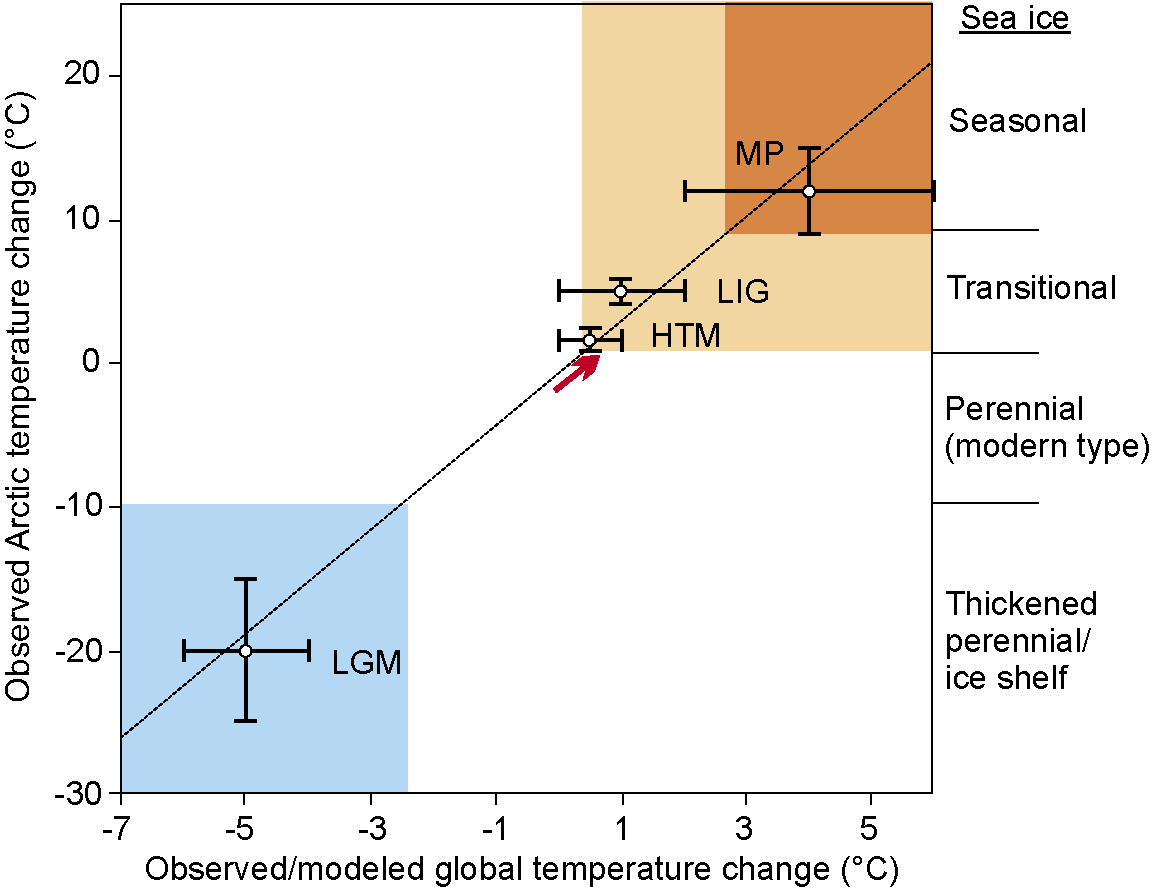- Home
- Publications
- PAGES Magazine
- Arctic Sea Ice - When Will The Arctic Ocean Become Ice-free and What Will Be The Effects? [Past]
Arctic sea ice - When will the Arctic Ocean become ice-free and what will be the effects? [Past]
Leonid Polyak
PAGES news
20(1)
19
2012
Leonid Polyak
Byrd Polar Research Center, Ohio State University, Columbus, USA; polyak.1 osu.edu
osu.edu
As Arctic sea ice is shrinking at an accelerating speed for the fourth decade in a row and summer ice extent numbers are falling well below the range of historical observations, much attention is placed on paleoclimatic reconstructions based on long-term time series. This situation necessitates a clear understanding of the nature and limitations of paleo records that can be employed in the Arctic Ocean. The most direct long-term records of sea-ice changes could be derived from seafloor sediments. Not surprisingly, Arctic paleoceanographic research is currently on the rise (Polyak and Jakobsson 2011). However, very low sedimentation rates in the central Arctic Ocean and the predominant lack of deposits older than the last deglaciation (last ca. 15 ka) on the continental shelves narrow the application of paleo data from these sedimentary archives for evaluating future changes (Polyak et al. 2010, and references therein). Useful information is also derived from coastal records and related paleoclimatic archives such as continental ice cores at the Arctic Ocean periphery (e.g. Macias-Fauria et al. 2009; Funder et al. 2011; Kinnard et al. 2011); but none of them can provide a continuous long-term record.
Due to these limitations one should not expect too accurate predictions of the future course and rate of ice retreat from paleo records; nevertheless, they contain a plethora of information on the state of the Arctic system at different climatic conditions of a much wider range than that of the recent centuries (Fig. 1). Notably, paleo data could shed light on the functioning of the seasonally mostly ice free Arctic and its role in the global climatic ensemble, which is essential for predicting environmental change in the very near future (e.g. Serreze and Barry 2011). One critical set of questions relates to the fate of Arctic biota, from microscopic organisms to polar bears, uniquely adapted to live in or in connection with a perennially ice-covered ocean. Disruption of habitats and life cycle of many Arctic species with shrinking sea ice and increasing temperatures is already underway, along with a northward migration of lower-latitude biota from both the Atlantic and Pacific oceans (Wassmann 2011, and references therein). Striking examples are the penetration of the Pacific diatom Neodenticula seminae via the Arctic into the North Atlantic (Reid et al. 2007) and the distribution of the coccolithophore Emiliania huxleyi from the Atlantic to the northern edge of the Barents Sea (Hegseth and Sundfjord 2008). Stratigraphic data indicate that these migrations likely happen for the first time since the end of the Early Pleistocene (ca. 800 ka) and the Last Interglaciation (ca. 130 ka), respectively.
Investigation of these and other relatively warm, low-ice time intervals of the past few million years, from the current interglaciation (Holocene) to Pliocene, when the Arctic paleogeography was generally similar to modern, has a potential to clarify questions related to the survival of Arctic biota and other impacts of reduced sea ice. This task, however, is complicated by the paucity of paleobiological/biogeochemical proxies in Arctic sediment records because of low marine primary production, overwhelming inputs of terrigenous organic matter, and widespread dissolution of both calcareous and siliceous material, as well as problems with reconstructing sea-ice conditions, which cannot yet be definitively evaluated by any known single proxy. Another complication arises from difficulties with establishing age constraints for Arctic Ocean sediments due to various adverse impacts of the ice cover. Recent achievements in developing sea-ice proxies and improving age controls are encouraging (Polyak and Jakobsson, 2011, and references therein), but much more needs to be done. Promising steps in this direction are underway such as the ESF program Arctic Paleoclimate and its Extremes (APEX) and the newly created PAGES working group on Sea Ice Proxies (SIP), and we can hope for exciting breakthroughs in the near future.
selected references
Full reference list online under: http://pastglobalchanges.org/products/newsletters/ref2012_1.pdf
Miller GH et al. (2010) Quaternary Science Reviews 29: 1779-1790
Polyak L el al. (2010) Quaternary Science Reviews 29: 1757-1778
Polyak L and Jakobsson M (2011) Oceanography 24: 52-64
Serreze MC and Barry RG (2011) Global and Planetary Change 77: 85-96
